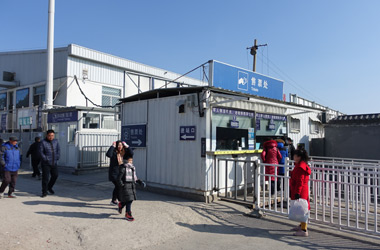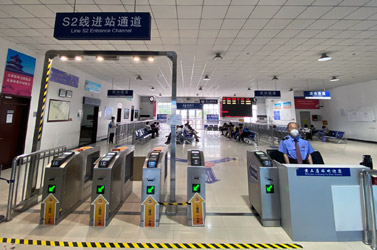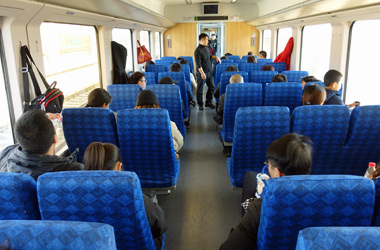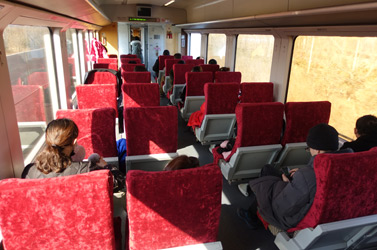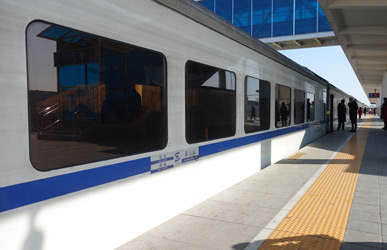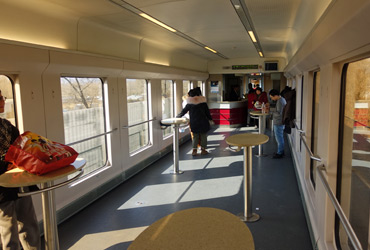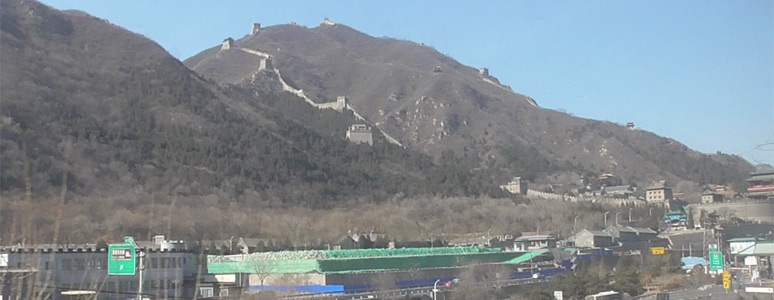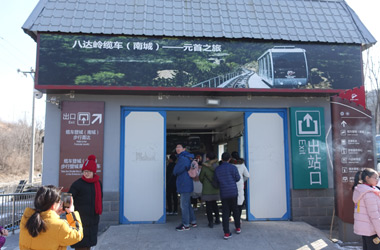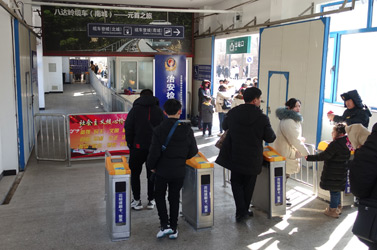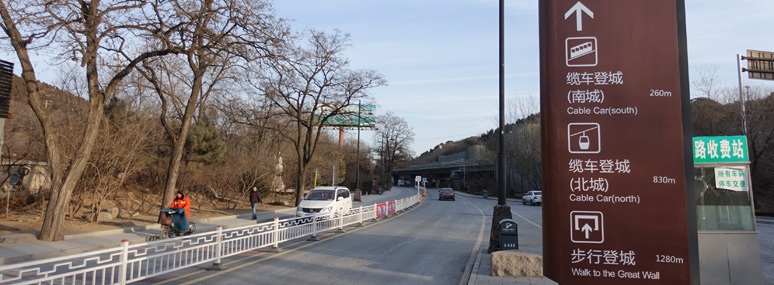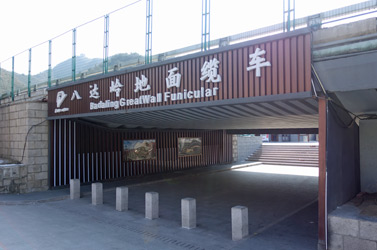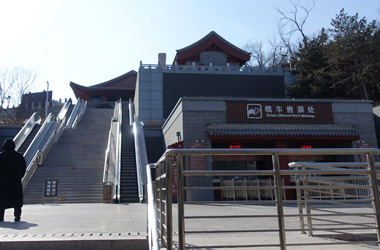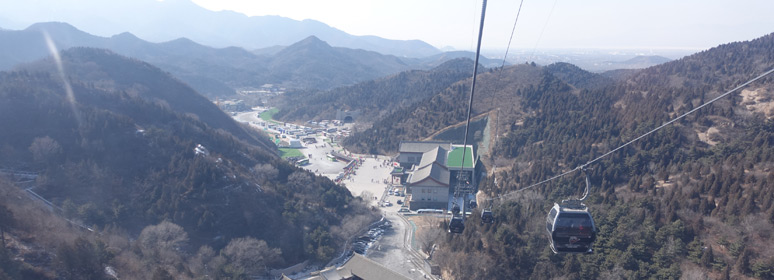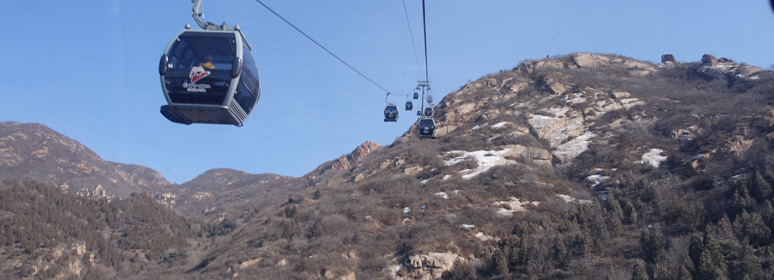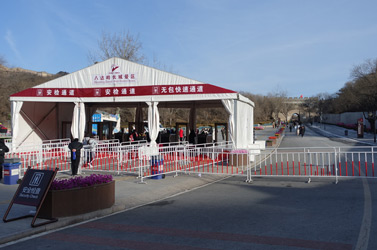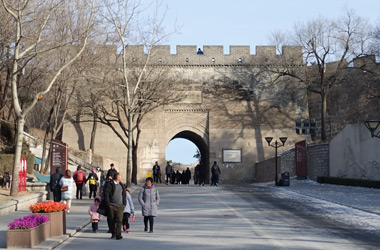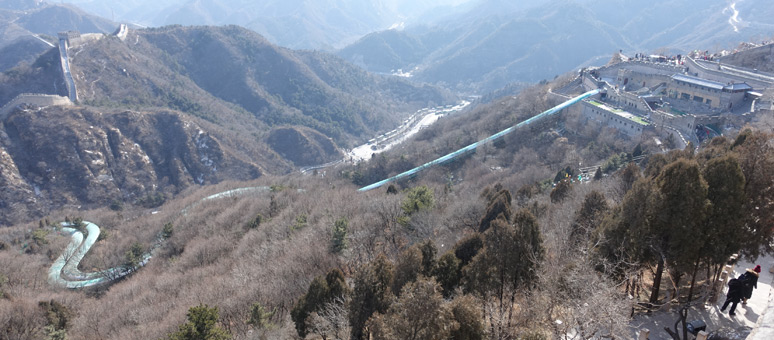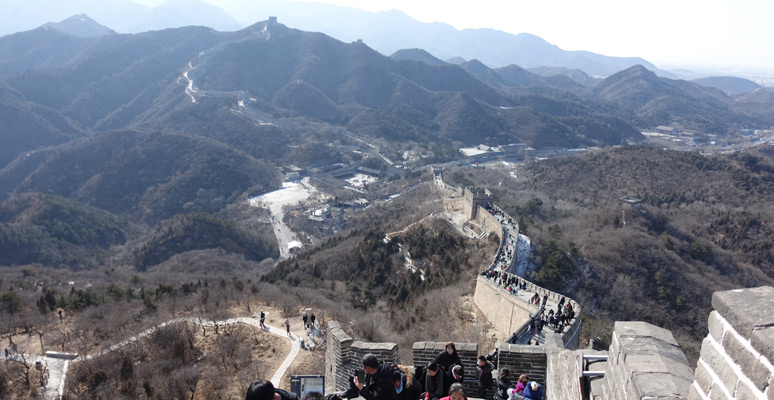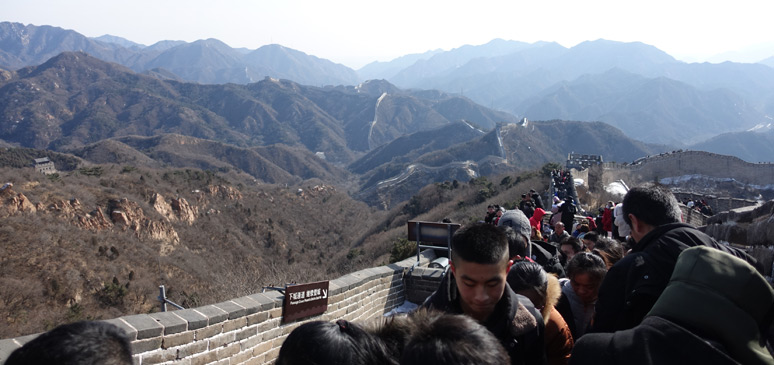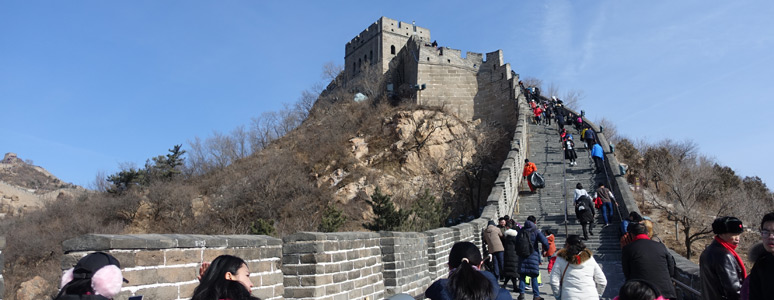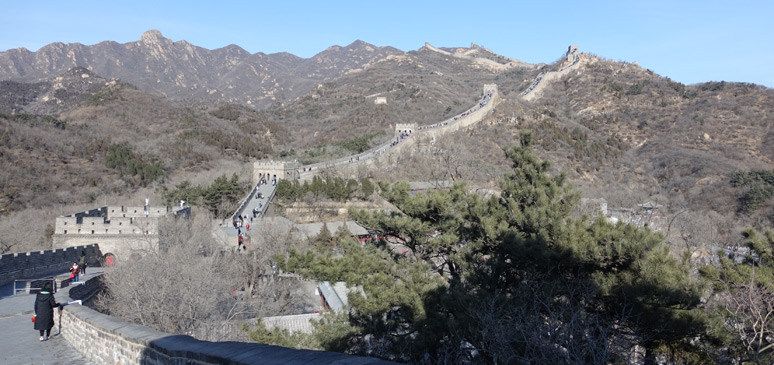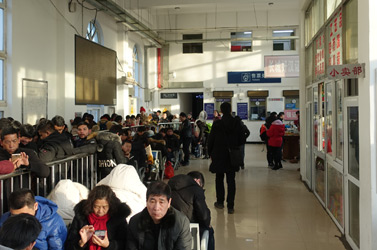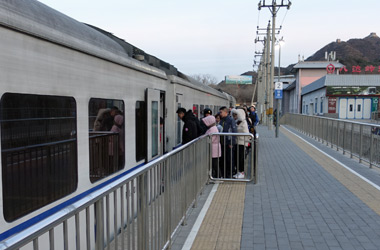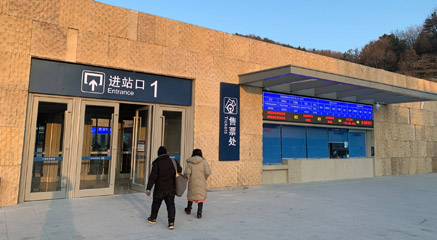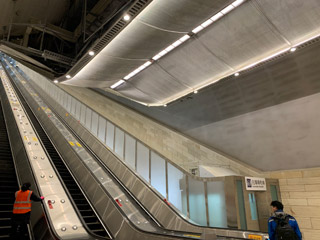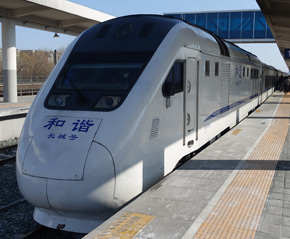 |
|
|
The best way to the Great Wall: An S2 train from Beijing to Badaling. |
A day trip to the Great Wall for $4
Badaling is the most famous & most-visited section of the Great Wall of China, an easy day trip just 61 km (38 miles) north of Beijing. I first went there on a one-day bus tour because I thought that would be easiest. We spent too much time in a cramped bus, wasted too much time at 'retail opportunities' and spent only 30 rushed minutes at the Great Wall. Never again! I now recommend that you visit the Great Wall cheaply & independently using the comfortable S2 trains which link Beijing and Badaling every couple of hours. Then you can explore the Great Wall at your leisure and return on whatever time train suits you. These S2 trains are comfortable, spacious & air-conditioned and even have a cafe car. They travel over the famous Imperial Peking–Kalgan railway with its famous switchbacks at Qinglongqiao, an experience in itself.
Important update: The S2 train is temporarily suspended from late 2025 for 1-2 years for construction work. Use the high-speed train instead
![]() How to visit the Great Wall
by train, in pictures
How to visit the Great Wall
by train, in pictures
![]() Video guide: A visit to the Great Wall by
train
Video guide: A visit to the Great Wall by
train
![]() SINCE 2020: The
high-speed train option
SINCE 2020: The
high-speed train option
Outward train times 2025
Return train times 2025
How to check current train times online
 |
 |
||
|
Alipay app. |
Being Subway app. |
These times get tweaked regularly so it's a good idea to check current ones. However, these S2 trains don't appear on any normal Chinese Railways online timetable as they are mere suburban trains. To check current S2 times:
1. Download the Alipay app for Android or Alipay app for iPhone. Add your phone number and nationality. Alipay is useful app to have for all sorts of reasons, including setting it up to touch in & out on the Beijing metro once you've added your credit card. It's in Chinese, but a floating Translate button at lower left lets you translate each page.
2. Search for Beijing subway in the Alipay search bar. Find the Beijing subway app by the Beijing Ruyi Technology Co with the red rings logo shown here.
3. Open the Beijing subway app and (tapping the Translate button on each page) click Suburban trains then Train timetable.
4. Now use the journey planner. Loess Shop Station is how it translates Beijing Huangtudian. Fortunately, Badaling is translated as Badaling!
How much does it cost?
Central Beijing to Huoying (for Huangtudian) by metro costs RMB 6 each way = 70p, €0.80 or $0.90.
Huangtudian to Badaling by S2 train costs RMB 7 each way = 80p, €0.90 or $1.
That's just £3.00, €3.70 or $3.80 from your hotel to the Great Wall, in total for a round trip...
How to buy tickets
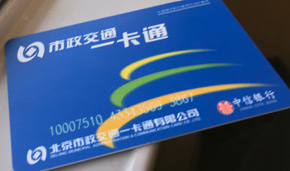 |
|
|
Beijing Metro smartcard (Yikatong) |
Option 1, at the station
Buy a Beijing Metro smartcard (also known as a Yikatong) from the staffed kiosk at any Beijing metro station. This works for both the Beijing Metro and the S2 local trains to and from Badaling. It's just like Oyster cards in London or Octopus cards in Hong Kong.
You pay 20 RMB refundable deposit (although they're been talking about discontinuing the need for a deposit) and ask to have it loaded with whatever credit you want - I suggest loading at least 50 RMB credit, which is enough for this trip and for the 16 RMB minimum credit you need to have on your card for it to work.
You then simply touch in and touch out through the automatic ticket gates in the metro from central Beijing to Huangtudian station, then touch in and touch out on the yellow-topped smartcard readers for the S2 train from Huangtudian to Badaling. No prior reservation is necessary or even possible, you just turn up and touch in. It's that simple. Just remember they may close the access gates 10 minutes before the train goes.
Option 2, using the Alipay app
You can now buy the Beijing Metro Card in the Alipay app on your phone, no deposit needed. Click on the transport icon, then the metro tab. You'll need to submit passport information and agree to their privacy terms. Load it with suifficint credit and it should then work the S2 line station gates.
Or you can buy a ticket for this specific journey in the metro part of the Alipay app. Once the metro mini-app is installed, the second tab in the bottom menu bar allows you to buy one-way metro tickets. Loess Shop Station is how it translates Beijing Huangtudian.
Normal paper tickets for the S2 line were discontinued in 2020.
How to visit the Great Wall, in pictures
Take the metro from central Beijing to Huangtudian station
1. Buy a Beijing Metro smartcard at whichever station is closest to your hotel and take the metro to Huoying station in the north of the city on lines 8 (green) & 13 (yellow), see www.johomaps.com/as/china/beijing/beijingmetro.html. The official metro website is www.bjsubway.com.
There's a simple X-ray & metal detector check at the entrance to all Beijing metro stations (you'll get used to this in China!), but this usually only takes seconds. You simply touch in through the automatic ticket gates with your Beijing Metro smartcard and touch out on the automatic ticket gates when you arrive at Huoying.
2. At Huoying metro station, follow the signs marked Line S2 (Huangtudian station) from the metro station ticket hall through the pedestrian tunnels to exit G4. It's all very clearly marked, you emerge into daylight up the steps at exit G4. At the top of the steps, do a 180 degree turn to your right and walk 100 metres or so along the clearly-marked path to Huangtudian station, see the photo below. Ignore any touts who tell you there are no trains and try to sell you a bus trip!
It's about 15 miles by metro from central Beijing to Huoying/Huangtudian, and in my case the whole trip from the lobby of the Hotel Beijing Nuo Forbidden City near Tian'anmen Square to Huangtudian station took 1h15 including the short walk to nearby Wangfujing metro station. I'd plan to arrive at Huangtudian 20-30 minutes before your chosen train.
Touch in at Huangtudian station
These trains previously used Beijing North station which is currently closed for reconstruction from November 2016 until further notice. They currently go from Huangtudian station, a small little-known station to the north of Beijing city. This could change in late 2019, so stay tuned - I'll post updates as soon as I hear anything.
At the entrance to Huangtudian station hall there's a simple X-ray check & metal detector, followed by ticket gates. Touch in with your Beijing metro smartcard.
Once inside the ticket hall, you wait for the doors to the platform to be opened, 10-15 minutes before the train leaves. Inside the ticket hall there's a counter selling drinks & snacks, there are toilets and a wall map of the Badaling site.
Take the S2 train from Beijing to Badaling
These modern air-conditioned diesel trains were built in the 1990s. They are remarkably spacious with huge tinted windows and they even have a cafe car with full-height windows, great for watching the Great Wall approach over a coffee or Chinese tea. The trains are fitted with 1st & 2nd class seats, but they're now operated as one-class only with just one price, so if you have any sense you'll make a bee-line for the wider and comfier 1st class seats at one end of the train. Yes, the trains have western-style toilets. Easily beats any cramped tour bus... See Beijing-Badaling train route map.
A journey on the Imperial Peking–Kalgan railway
This isn't any old train ride. It's a journey over the Imperial Peking–Kalgan railway, built 1905-1909, see en.wikipedia.org/wiki/Beijing%E2%80%93Baotou_railway. This was the first railway to be built by the Chinese themselves without western help, by a US-educated Chinese railway engineer called Zhan Tian-you (b.1861-d.1919), known as the Father of Chinese Railways. You can read more about him at en.wikipedia.org/wiki/Zhan_Tianyou.
The northern suburbs... After leaving Huangtudian, the train runs sedately across the northern suburbs. You'll pass various industrial sites and tower blocks, but the mountains soon come into view.
First sight of the Great Wall... As the mountains north of Beijing get closer, you'll soon spot the Wall from the train...
Along the Guan Valley... The train now enters a deep valley. You'll now see Great Wall on both sides of the train - if this seems odd, here's the explanation:
Broadly speaking, the Great Wall of China runs along the mountain range north of Beijing, protecting China in the south from what was once the Tatar badlands to the north.
However, at this point the Guan Valley forms a passageway through the mountains. The Great Wall turns to run along one side of the Guan Valley as far as Badaling, it then crosses the valley with a gateway and fort on the valley floor (this is the famous Badaling section of Wall) then it runs back along the other side of the Guan Valley before turning again to continue its usual course along the mountain range.
So at this point there is Great Wall on both sides of the Guan Valley, forming a safe passage for Chinese forces to advance through the mountains along the Guan Valley to Badaling, just short of the Tartar plains. When necessary, the Chinese could sally forth into Tartar territory from the fort and gateway in the Great Wall at Badaling. It took me 27 years to work this out!
The switchback at Qinglongqiao West... The railway climbs steeply up the Guan Valley, you'll feel the train struggling slowly up gradients as steep as 3.3% (1 in 30). Chinese railway engineer Zhan Tianyou famously used a switchback on this route to gain height. Around 10-15 minutes before Badaling, the train takes a sharp left hand curve into a side valley and comes to a stand at Qinglongqiao Xi station (Xi = West). It's not a passenger stop so the doors remain closed. The train changes direction and leaves Qinglongqiao West the way it went in, turning sharp left again to continue up the valley towards Badaling. The train passes through a tunnel under the famous section of Great Wall and shortly after emerging from that it arrives at Badaling station. There are in fact two switchbacks with reversing stations on opposite sides of the Guan Valley, one for northbound trains and one for southbound trains. On your way back you'll use the eastern switchback reversing at Qinglongqiao main station where Zhan Tianyou is buried. See this on a rail map of China.
The S2 train arrives at Badaling on a chilly February afternoon. The train continues one stop to Yanqing, but almost all passengers get off here.
Arriving at Badaling station
Leave the platform through the end of the station building, touching out with your smartcard on the orange-topped posts.
You emerge into the road from the station exit, marked by the blue arrow. When you return, the station entrance is the one with the blue sign above it, to the right of the exit.
Remember that your train has passed underneath the Great Wall in a tunnel, and Badaling station is on the far (Tartar!) side of the Wall. So you leave the station, cross the road on the zebra crossing and turn left along this road in the direction of the red arrow, back alongside the railway on which the train arrived.
Option 1, walk 260m from Badaling station to the South funicular
From Badaling railway station, just walk along the road shown in the photo above following all the other passengers, and the entrance to the South funicular is on that road on the right. It's mistakenly called a cable car on some maps & signs. The funicular costs around 100 RMB, you buy the park entrance ticket (40 RMB in summer, 35 RMB winter) and the funicular ticket together at the ticket counter.
The funicular takes you to the top of the Great Wall on the South side of the valley. From there you can walk down along the Wall to the valley floor then either leave from of the main entrance at the bottom, or (if you're feeling energetic) continue along the Wall up the North side of the valley and return to the valley floor using the North cable car.
The Wall on the South side of the valley is usually less crowded than the North side, although not quite as high and less-photographed.
Option 2, walk 830m from Badaling station to the North Cable Car
You walk along the road shown in the photo above for about 350m to a major junction, then turn left, following the signs to the North Cable Car station. The cable car costs around 100 RMB one-way or 140 RMB return, you buy the park entrance ticket (40 RMB in summer, 35 RMB in winter) and the cable car ticket together at the ticket counter. There's the usual quick X-ray & metal detector check at the entrance to the building.
The North cable car takes you almost to the top of the Wall on the North side of the valley. From there you can walk down along the Wall to the valley floor then either leave from of the main entrance at the bottom, or (if you're feeling energetic) continue along the Wall up the South side of the valley, returning to the valley floor using the South funicular.
Walking into the North cable car station. The bus is one of the free shuttle buses from the station carrying a '000' number.
Looking back down at the cable car station. The ride only took a few minutes...
Option 3, walk 1280m from Badaling station to the main Great Wall entrance.
This is a largely level walk (well, slightly uphill but not hugely) from the station along the valley to the main visitor entrance at the bottom of the valley. Here you pay the park entrance fee (40 RMB in summer, 35 RMB in winter) and you can then walk up either the North or South side of the valley (or both) as you wish. This is the cheapest option, but with the most climbing!
There's an X-ray & metal detector check for all Wall visitors, as shown in the photo above left. You then walk further along the road and through the impressive main archway in the photo above right. On the other side is the ticket office and entrance to the Great Wall, see the photo below.
Option 4, the pulley
For the sake of completeness, there's one more way to get up or down the wall. This is a strange ride not dissimilar to a roller coaster where you are pulled up or let down on a trackway, which you can see in the photo below. The bottom of the pulley is on the far side of the mountain from Badaling station, so it's not the most accessible without a longish walk.
The Man in Seat 61 says...
"I had a leisurely breakfast and left Beijing on the 11:32 train. At Badaling I walked from the station and took the North cable car, an experience in itself. Mid-week in February there was hardly any queue for the cable car, even at the tail end of the busy Spring Festival. However, the Wall was jammed solid with people trying to climb to the very highest North side towers above the cable car station. I gave up with that and walked down the Wall to the valley floor, with minimal crowds. This didn't take long, so I then walked up the South side intending to take the funicular down. That wasn't running, so I walked back down the way I had come and out of the main Great Wall entrance in the bottom of the valley. There was still plenty of time for a coffee and something to eat before taking the 17:37 train back to Beijing..."
Free shuttle bus
If you really don't want to walk there's a frequent free shuttle bus from Badaling station to the Great Wall main entrance. It leaves from a stop across the road opposite the station, it's coloured green and carries bus number '000' on the front. However, it's just as easy and almost as quick to walk.
Walking the Great Wall
The photo above looks south along the Wall from just below the North cable car station. Old imperial China is inside the Wall to the left, the 'Tartar badlands' are outside the Wall to the right. In the foreground, the Wall snakes down the north side of the valley to the fort and main entrance in the bottom of the valley (in the centre of the photo). In the background it continues back up the South side of the valley. At centre right you can see the approach road leading from the main entrance towards Badaling station, which is out of shot to the right.
Also taken looking north from below the North cable car station, across the Guan Valley towards the South side. The mountain scenery is quite spectacular, Wall or no Wall...
A section of wall on the north side...
Now we're looking back north from the bottom of the valley - the large tower in the foreground is at the main entrance to the Wall. This photo shows the Great Wall snaking up the north side of the valley with the North cable car upper station more or less on the skyline, just below the highest tower visible in the far background.
Taking the train back to Beijing
There's the usual X-ray and metal detector check at Badaling station entrance. Once inside the station hall there are toilets and a snack counter selling drinks & snacks. The photo below left shows passengers queuing for the 17:37 train back to Beijing. Passengers are let onto the platform 10 minutes before the train is due. You just touch in with your Beijing Metro smartcard as you go onto the platform. In this direction, don't miss the statue of engineer Zhan Tianyou at Qinglongqiao station.
The switchback at Qinglongqiao... In this direction, the train uses a different switchback on the eastern side of the Guan Valley. 10 minutes after leaving Badaling station the train takes a sharp left turn into a side valley, and you'll see the Great Wall of China coming down the steep walls of this side valley on both sides of the train, see the photo below. The train makes a dramatic entrance through this section of Great Wall into Qinglongqiao main station.
If you look to the left as the train enters Qinglongqiao you'll see the statue of Zhan Tianyou, father of Chinese railways and the man who engineered this railway line. His is buried here at Qinglongqiao station.
The train changes direction at Qinglongqiao, spelt Chinglungchiao on the old station building, pictured below. It's not an official station stop so the doors remain closed. The train heads back out between those dramatic sections of Great Wall, making another sharp left turn back down the Guan Valley towards Beijing, See this on a rail map of China.
The Trans-Siberian connection: Until the early 2000s Trans-Siberian train 3/4 between Moscow & Beijing was routed over this historic bit of railway. In 1991 I travelled from Moscow to Beijing on train 4, and vividly remember passing through the Great Wall into Qinglongqiao station and reversing. At the time I did not realise that we'd just passed non-stop through Badaling station and passed under the Great Wall in a tunnel. For 27 years I wondered why we passed through this bit of Wall into Qinglongqiao then passed back through it again to reach Beijing! Moscow-Beijing trains 3/4 and most other long-distance trains are now routed via the faster and more easily-graded Fengsha Railway, built in the 1950s.
New high-speed line from Beijing to Badaling opened in 2019
As you walk from Badaling station towards the North cable car you pass a building on your right, just a few hundred metres before the cable car station. This is the new Badaling high-speed rail station on the Beijing-Zhangjiakou Railway, with its platforms in tunnels underground. It's now the world's deepest high-speed station, 102m below ground. High-speed trains from Beijing North to Badaling started in December 2019.
Watch the video
New high-speed train to the Great Wall
The new Beijing North – Zhangjiakou high-speed railway opened on 30 December 2019, and this has a new underground high-speed station at Badaling called Badaling Great Wall, also known as Badaling Changcheng. Then platforms are 102m below the surface, making it one of the world's deepest high-speed stations if not the deepest. Badaling Great Wall is closer to the Wall than the classic Badaling station, it's located a stone's throw from the Great Wall's South cable car station. Unlike the S2 suburban trains, these high-speed trains are all-reserved so require pre-booking and sell out close to departure date.
-
Up to 8 high-speed trains per day now run from Beijing North to Badaling Great Wall station, journey time 34 minutes.
-
Fare around 27 RMB ($4) in standard class, 44 RMB ($6) in 1st class or 83 RMB ($12) in luxurious business class.
-
Tickets sell out as departure approaches, so book ahead for this high-speed option - or use the S2 turn-up-and-go service instead.
-
Book at www.trip.com, specifically selecting Beijing North to BadalingChangCheng. Trip.com charges the official Chinese Railways price plus an RMB 30 ($5) fee per ticket, which they call a Hotel Promotion Code.
-
Or book a high-speed train easily at reliable train booking agency 12go.asia, using this special direct link.
-
You can see photos of 2nd, 1st & business class on a Fuxing (Revival) train here. On arrival at Badaling you leave the underground platform and go up huge escalators to the station building at ground level, and out of the exit ticket gates. Tip: If using this route to return to Beijing from Badaling, ticket gates are locked 12 minutes before departure. That's to allow you to descend the huge escalators down to platform level.
My suggestion: High-speed out, classic S2 back... I'd be perfectly happy using the classic S2 train both ways, it's more flexible as it needs no reservation and you see more, anticipation building as the Wall comes into view and you head up the Guan Valley on the original historic railway. But if you haven't experienced China's amazing high-speed rail network before, taking the new high-speed train to the Wall is an experience in itself. If you want to use the high-speed line I recommend going outward by pre-booked high-speed train and returning on the classic S2 train using your Beijing metro smartcard, then you experience both. Doing it this way round keeps your return time open so you can linger longer at the Wall if you like, second because in the southbound direction the S2 train goes via the eastern Qinglongqiao station switchback, rather than the less important western Qinglongqiao Xi switchback, so you see the statue and grave of Zhan Tianyou, railway engineer and father of Chinese railways.



